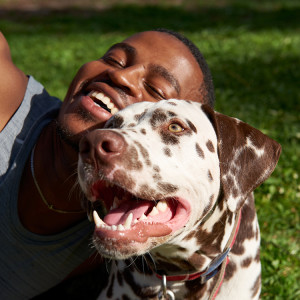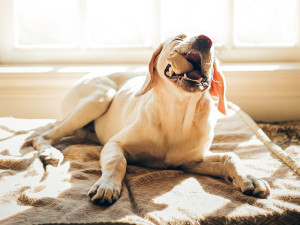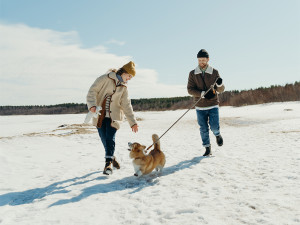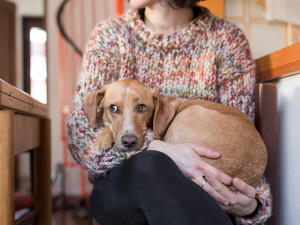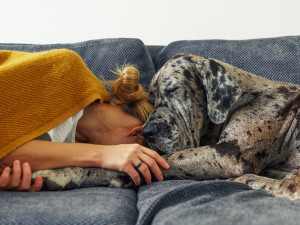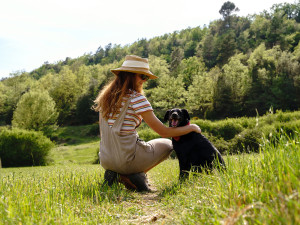Why Dog Orthodontics Exist and Why Your Pup May Need Them
Braces are actually the most gentle way of dealing with your dog’s malocclusion (aka a ‘bad bite’)
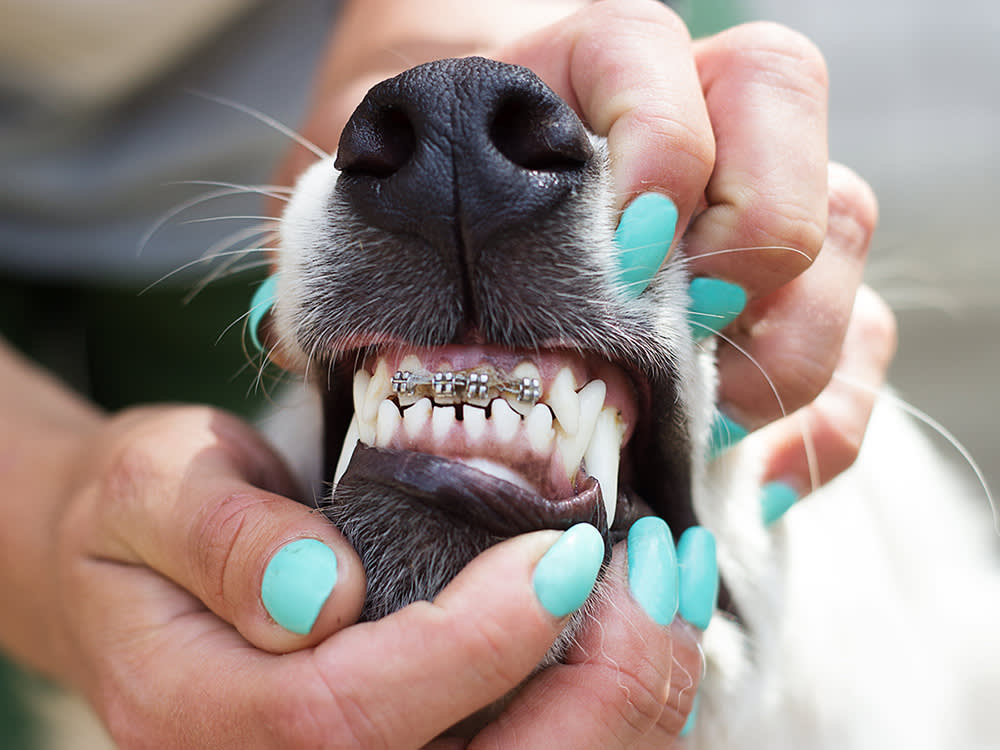
Share Article
Wilbur, a four-month-old Dachshund with a dash of Papillon or Chihuahua in the mix, was to be my first foster pup. A standout at the shelter, his irresistible face and personality sealed the deal. Once I got him home, I noticed that his lower jaw was considerably shorter than the upper one. Although he appeared to be almost chinless, it made his smile more pronounced. No big deal, I thought – he’s so adorable.
Two months later, I had him neutered, and when I picked him up, a handwritten note attached to his aftercare instructions suggested that he should be seen by an orthodontist immediately. My first response, like that of most people unfamiliar with this veterinary specialty, was one of disbelief. I thought perhaps it was some kind of joke. But no. According to my vet, Wilbur had a malocclusion (a misalignment of the teeth) that required treatment – the sooner, the better.

littleKin™ is Kinship’s home just for puppy and kitten parents. Bop over to check out expert advice, new pet tools, and special deals—all curated for your newest family member.
opens in a new tabLuckily, I found Dr Jennifer Lynn, DVMopens in a new tab, who has dedicated her practice exclusively to canine and feline dentistry for the past 15 years. Dr Lynn explained Wilbur’s Type II, base-narrow malocclusion to me. His mandible (lower jaw) was much shorter than his maxilla (upper jaw), resulting in what most people refer to as an overbite. In growing pups, the jaws sometimes develop at different rates, but Wilbur’s situation was so extreme that there was no chance of the lower jaw ever catching up.
This was more than a vanity issue: his mandibular canines, which normally wing out in front of the maxillary canines, were not only behind them, but were ‘linguoverted’ – which means angled inward towards his tongue. Since his permanent teeth were still coming in, they hadn’t had time to do damage, but eventually this misalignment could prevent him from closing his mouth, as well as injure his palate. The good news was that if treated early, the teeth could easily be shifted to give Wilbur a healthy, comfortable bite.
Why not just pull them? According to Dr Lynn, canine teeth are important. Their roots are roughly double the length of their crowns, so removing them requires oral surgery and, sometimes, a bone graft. Lower canines make up a good portion of the chin, help hold the tongue in place, and are used for grasping.
There’s also something called a crown reduction, where the dentist reduces the height of the mandibular canines. In cutting the crown, the tooth’s pulp is exposed. A small portion of the pulp is removed and the top of the tooth is shortened and reformed. Called a vital pulpotomy, it’s not without potential complications and needs to be monitored with annual dental X-rays.
Ball therapy is another option: teeth can sometimes be moved into place in response to pressure generated by the dog chewing on an appropriately sized rubber ball for 15 minutes three times a day. But if, like Wilbur, the dog has no interest in anything of the sort, they you can’t try that approach.
Canine orthodontics – braces – are actually the most gentle way of dealing with a malocclusion. Rather than surgically removing the teeth, they are carefully coaxed into position. And yes, they do come with rubber bands – or elastic chains, as they’re also called. With Wilbur under anaesthesia, buttons were cemented to the lower canines and molars at the back of his mouth. Pressure supplied by elastic chains attached to the buttons would gradually shift his teeth to the desired position.
Keeping the elastic chains intact proved to be the biggest challenge. Almost daily, Wilbur managed to dislodge one while chewing on found objects. I became an expert on reattaching them. Once, he managed to pop off a button and had to be anaesthetised so a new one could be put on. Thankfully, treatment is of short duration – two or three months on average. Wilbur didn’t require a retainer, though some dogs do. Once everything’s in place, it tends to stay that way because the dog’s normal bite acts as a natural retainer (if only that were the case for humans, too).
Others I spoke with have had equally positive experiences with dog braces. Following the devastating loss of a beloved dog, Brenda Lyum and her husband, Mark, brought home a Brittany Spaniel puppy, whom they named Abbey. During their first vet visit, the doctor took one look at Abbey’s mouth and commented that her severe overbite, a genetic defect, was reason to send her back to the breeder. But the Lyums were committed to caring for their new companion, so Brenda and Abbey made weekly visits to Dr Lynn’s office.
During Abbey’s treatment, everyone marvelled at the five-month-old puppy’s orthodontic appliances, which included a palatal expander with acrylic splints on both sides, in addition to buttons, chains and composite extensions. They were amazed at what could be done. At a price not significantly different from the cost of extraction surgery, the Lyums were able to save Abbey’s teeth. And unlike my rambunctious Wilbur, Abbey kept everything in place until her corrections were complete.
Dr JP Gonzalez-Torres, a general dentist (for humans), was surprised to find that Piper, his 10-month-old female Wire Fox Terrier could be treated for a malocclusion resulting from a retained primary, or persistent deciduous tooth. When his veterinarian recommended that he take Piper to Dr Lynn, Dr Gonzalez-Torres was intrigued. “As a dentist, I got really excited about the idea of a pet orthodontist. I didn’t know they existed. We were able to correct the issue in a relatively short period of time. Piper did great throughout treatment. For those who question it, the price can be steep, but the end result is amazing. If you can correct a dental issue that could affect the life of your pet, wouldn’t you do it?”
Veterinary dentists Dr Anson Tsugawa, who specialises in oral surgery for trauma, fractures and conditions such as oral cancer at Dog and Cat Dentist, Incopens in a new tab. in Los Angeles, believes that every dog is entitled to a comfortable bite. On occasion, however, he has had to explain that veterinary orthodontic techniques are performed only to improve function, for comfort and to eliminate traumatic damage to the mouth – not for cosmetic reasons.
Because older animals may take longer to treat, dogs should be evaluated as early as possible to prevent or correct dental problems. To avoid complications, multiple visits are required as treatment progresses, so proximity to the dentist is important. For those who must travel long distances and would appreciate fewer appointments, Dr Tsugawa says some dogs can be fitted with an appliance that their guardian can tighten with a little wrench. Since each dog’s mouth is unique, a dental specialist or certified veterinary dentist is the best judge of how to proceed.
While Wilbur’s treatment was successful, my fostering was not: he became a permanent part of the family the moment he first scampered through our door. And on our walks, his smile continues to charm every person we meet.
Paula Maxwell
Paula Maxwell is a writer.
Related articles
![Pet parent comforting anxious dog by holding their paw]() opens in a new tab
opens in a new tab8 Tips for Helping an Anxious Dog
Easy ways to calm your pup’s nerves
![shy dog frightened in the arms of the owner. this brown mixed-breed hound puppy has a sweet gaze. the female owner has a wool sweater]() opens in a new tab
opens in a new tabWhy is My Dog Shaking? Causes and Treatment
A vet explains why the weather isn’t always to blame
![A woman and a dog laying close together on a couch.]() opens in a new tab
opens in a new tabPaging Dr Doggo
Your pup may know you’re sick before you do
![A woman in beige overalls a striped shirt and a straw hat, smiling, with her arm around her black dog sitting in the grass on a green hill.]() opens in a new tab
opens in a new tabThe Best Flea and Tick Preventatives and Treatments For Dogs
Because an infestation is the last thing your pup – and your home – needs
